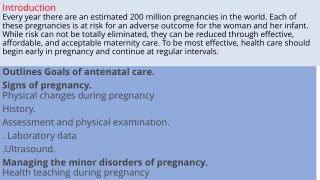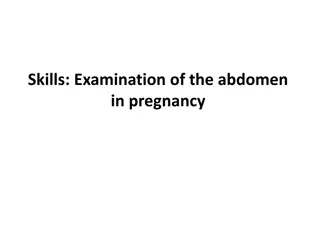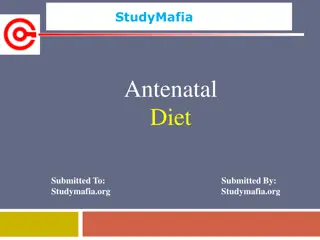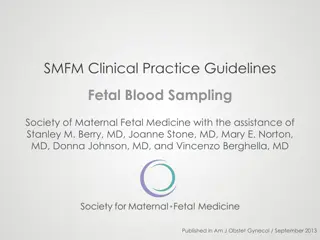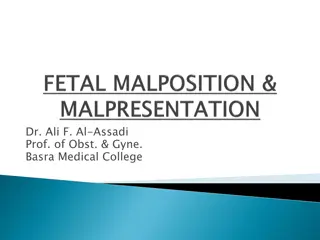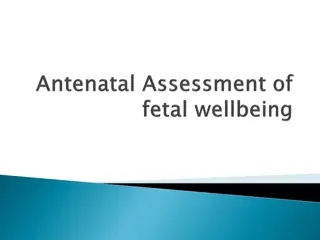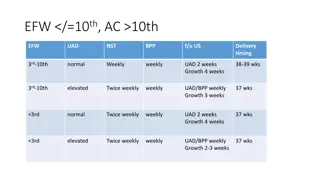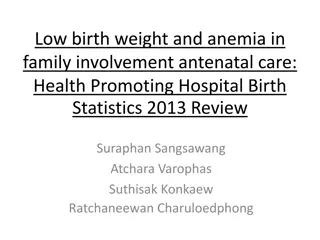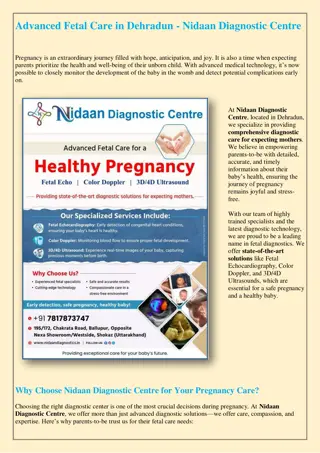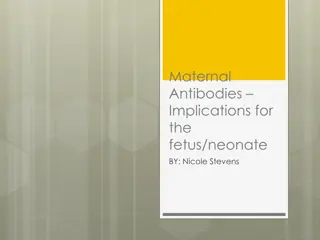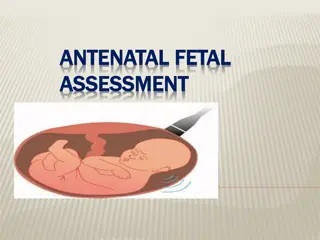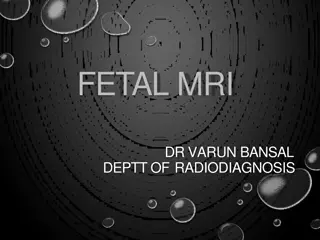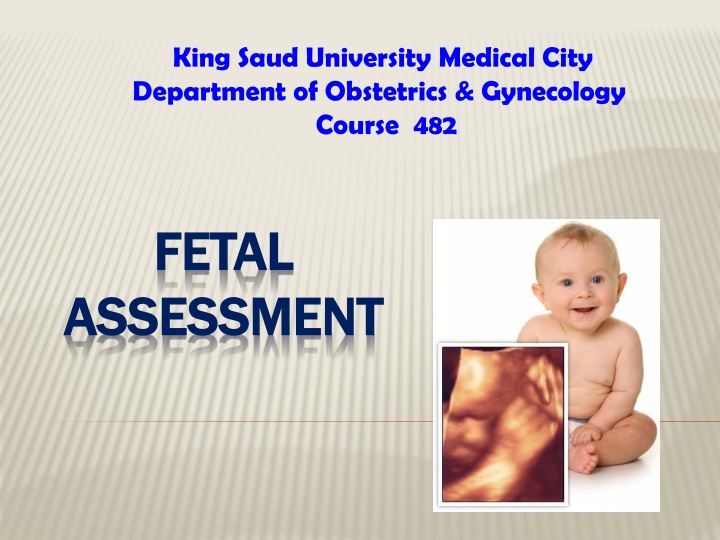
Fetal Assessment in Obstetrics & Gynecology
Learn about the importance of fetal assessment in identifying neurological risks in pregnancies. Explore early and late pregnancy assessments, fetal movements, heart activities, and rational strategies for optimal fetal oxygenation. Discover the crucial techniques used in assessing fetal well-being during different stages of pregnancy.
Download Presentation

Please find below an Image/Link to download the presentation.
The content on the website is provided AS IS for your information and personal use only. It may not be sold, licensed, or shared on other websites without obtaining consent from the author. If you encounter any issues during the download, it is possible that the publisher has removed the file from their server.
You are allowed to download the files provided on this website for personal or commercial use, subject to the condition that they are used lawfully. All files are the property of their respective owners.
The content on the website is provided AS IS for your information and personal use only. It may not be sold, licensed, or shared on other websites without obtaining consent from the author.
E N D
Presentation Transcript
King Saud University Medical City Department of Obstetrics & Gynecology Course 482 FETAL FETAL ASSESSMENT ASSESSMENT
FETAL ASSESSMENT FETAL ASSESSMENT Fetal assessment is to identify fetuses at risk of neurologic injury or death in order toprevent it It can be divided into: -early pregnancy fetal assessment -late pregnancy fetal assessment OR OR - -assessment of low risk pregnancy - -assessment of high risk pregnancy
RATIONAL RATIONAL fetal oxygenation challenged: - blood flow directed to brain, heart & adrenal & blood flow away from the kidney fetal urine production decrease AF volume. - CNS hypoxia Fetal movement decrease -chemoreceptor's vegally-mediated reflex Fetal heart rate abnormality late deceleration. decrease
EARLY PREGNANCY ASSESSMENT Fetal heart activity Fetal heart activity fetal auscultation (special stethoscope or fetal auscultation (special stethoscope or doppler doppler) ) ~ ~12 12weeks weeks
fetal heart activity seen by USS fetal heart activity seen by USS Can be seen from Can be seen from 6 6weeks weeks
EARLY PREGNANCY ASSESSMENT Fetal movement Fetal movement Fetal movement are usually first perceptible to mother Fetal movement are usually first perceptible to mother ~ ~17 17w w- -20 20w (quickening) w (quickening) 50 50% of isolated limb movements are perceived % of isolated limb movements are perceived 80 80% of trunk and limb movements % of trunk and limb movements Fetal growth Fetal growth SFH SFH USS USS
LATE PREGNANCY ASSESSMENT LATE PREGNANCY ASSESSMENT Fetal movement counting Fetal movement counting kick chart Contraction stress test Contraction stress test CST Non stress test Non stress test NST NST Doppler Velocimetry Doppler Velocimetry UAV amniotic fluid index amniotic fluid index AFI kick chart CST UAV AFI
FETAL MOVEMENT COUNTING FETAL MOVEMENT COUNTING It should be started ~ It should be started ~28 &~ &~24 24w in high risk pregnancy w in high risk pregnancy It can reduce avoidable stillbirth It can reduce avoidable stillbirth CARDIFF TECHNIQUE CARDIFF TECHNIQUE - -10 10 movement in movement in 12 - -If abnormal patient should get further assessment If abnormal patient should get further assessment SADOVSKY TECHNIQUE SADOVSKY TECHNIQUE - -4 4 movement /hour if not felt another hour movement /hour if not felt another hour If not patient need more assessment If not patient need more assessment 28w in normal pregnancy w in normal pregnancy 12 hours hours
CONTRACTION STRESS TEST (CST) Causing uterine contraction over 20minutes At least 2 uterine contractions Uterine contraction restrict O2 delivery to the fetus Normal fetus will tolerate contraction Hypoxic fetus will have late deceleration High false positive rate ~50% 100% true negative rate
NON STRESS TEST (NST) Maine advantage over CST is no need for contraction False +ve & false ve higher than CST done
NON STRESS TEST NON STRESS TEST The base line The base line 120 Different criteria in fetuses < Different criteria in fetuses <32 Reactive: Reactive: At least two accelerations from base line of At least two accelerations from base line of 15 bpm bpm for at least for at least 15 15 sec within sec within 20 Non reactive Non reactive: : No acceleration after No acceleration after 20 20 minutes another another 20 20 minutes minutes 120- -160 160 beats/minute beats/minute 32w w 15 20 minutes minutes minutes- - proceed for proceed for
NON STRESS TEST ( NON STRESS TEST (NST) NST) If non reactive in 40 minutes---proceed for contraction stress test or biophysical profile The positive predictive value of NST to predict fetal acidosis at birth is 55%
AMNIOTIC FLUID VOLUME ~AFI Amniotic fluid index AFI -the sum of the maximum vertical fluid pocket diameter in four quarters -the normal value 5-25cm -<5~ oligohydraminous ->24cm polyhydraminous
BIOPHYSICAL PROFILE (BPP) Combines NST with USS estimation AFV, fetal breathing, body movement & reflex/tone/extension-flexion movement . it is a scoring system it is done over 30minute It measure acute hypoxia(NST, body mov. &breathing) & chronic hypoxia (AFI)
FETAL BIOPHYSICAL PROFILE/NST+ Normal (score=2) Biophysical Variable 1 episode FBM of at least 30 s duration in 30 min movements Abnormal (score= 0) Absent FBM or no episode >30 s in 30 min 2 or fewer body/limb movements in 30 min Fetal breathing Fetal movements 3 discrete body/limb movements in 30 min Fetal tone 1 episode of active extension with return to flexion of fetal limb(s) or trunk. Opening and closing of the hand considered normal tone Either slow extension with return to partial flexion or movement of limb in full extension Absent fetal movement Either no AF pockets or a pocket<2 cm in 2 perpendicular planes Amniotic fluid volume 1 pocket of AF that measures at least 2 cm in 2 perpendicular planes
BPP The risk of fetal death within 1 week if BPP is normal~ 1/1300 Modified BPP (mBPP) -NST & AFI -low false negative 0.8/1000 -high false positives ~60%
DOPPLER VELOCIMETRY Measurement of blood flow velocities in maternal & fetal vessels Reflect fetoplacental circulation Doppler indices from UA, Uterine A & MCA Doppler studies is mostly valuable IUGR In IUGR absent or reversed EDF (end diastolic flow) associated with fetal hypoxia
INVASIVE FETAL ASSESSMENT Amniocentesis
AMNIOCENTESIS Obtaining a sample of amniotic flui during pregnancy. Obtaining a sample of amniotic flui during pregnancy. Usullay done after Usullay done after 15 15w (can be done after w (can be done after 11 Indication Indication -genitic (karyotype) genitic (karyotype) - -billirubine level (RH billirubine level (RH- -isimunisation) isimunisation) - -fetal lung maturity (L/S) fetal lung maturity (L/S) - -therputic in polyhydranios therputic in polyhydranios Risks: ROM ~ Risks: ROM ~1 1%, abortion %, abortion 0.5 11w) w) 0.5%, infection %, infection 1 1/ /1000 1000
CVS CHORIONIC VILLUS SAMPLING Usually done after 10w It is the procedure of choice for first trimester prenatal diagnosis of genetic disorders Complication: fetal loss (0.7 CVS procedure and CVS procedure and 1.3 1.3 percent within percent within 30 induced limb defects Second trimester amniocentesis is associated with the lowest risk of pregnancy loss; chorionic villus samplings safer than early (ie, before 15 weeks) amniocentesis. 0.7 percent within percent within 14 30 days) 14 days of a TA days of a TA days), , Procedure- .
CORDOCENTESIS Indication: - rapid karyotyping -diagnosis of inherited disorders -fetal HB assessment -fetal plt level -fetal blood transfusion Complication: bleeding, bradycardia, infection .
Thanks & Thanks & good luck good luck

